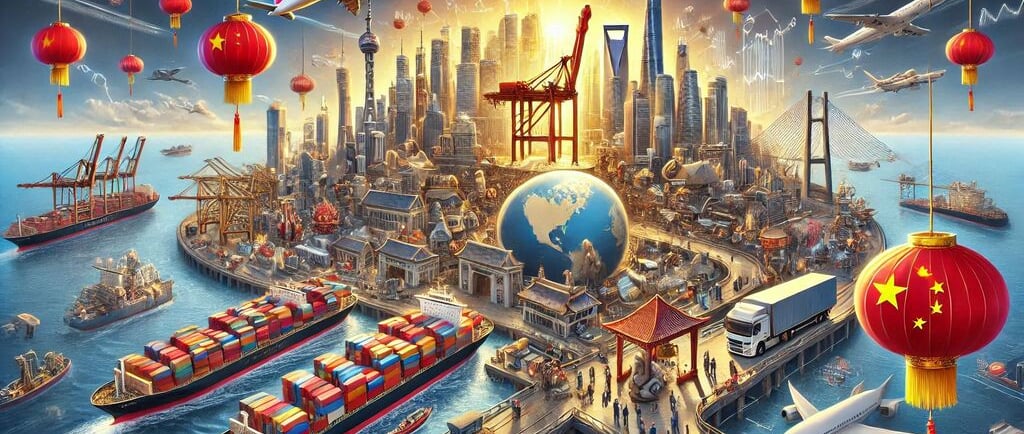Let us collaborate to foster global growth and development together.
Understanding China's Export Landscape: Key Industries and Market Trends
Dive into China’s export landscape with insights on key industries and market trends. Discover the driving factors shaping global trade.
CHINA
10/31/20243 min read


Meta Description: Dive into China’s export landscape with insights on key industries and market trends. Discover the driving factors shaping global trade.
Understanding China's Export Landscape: Key Industries and Market Trends
China’s export landscape plays a pivotal role in shaping the global economy. With its diverse industries, technological advancements, and strategic market trends, China has earned its position as a global trade powerhouse. In this article, we’ll explore the essential industries driving exports, key market trends, and how businesses worldwide can leverage opportunities in this dynamic environment.
Why Focus on China’s Export Landscape?
China is the world’s largest exporter, contributing significantly to global trade dynamics. Its ability to innovate, scale, and adapt to market demands has made it a preferred partner for businesses worldwide. Understanding China’s export landscape can provide valuable insights for:
Identifying New Business Opportunities: Learn which industries dominate the export market.
Staying Ahead of Market Trends: Gain insight into evolving trade practices and technologies.
Building Strategic Partnerships: Explore potential collaborations within China’s key export sectors.
Key Industries Driving China’s Export Growth
1. Electronics and Technology
China is synonymous with electronics and technology. From smartphones to semiconductor components, the country’s expertise and efficiency in production dominate global markets.
Major Players: Leading brands like Huawei and Xiaomi, alongside smaller manufacturers, cater to both consumer and industrial demands.
Global Influence: In 2022, electronics accounted for over 35% of China’s total exports, reflecting its strength in this sector.
2. Machinery and Equipment
Another heavyweight in China’s export portfolio is machinery and equipment. This category includes heavy industrial machinery, automotive parts, and specialized tools.
Industries Served: Construction, automotive manufacturing, and renewable energy.
Example: Exports of robotics and automation equipment are rising rapidly as industries worldwide embrace digital transformation.
3. Textiles and Apparel
China has long been a leader in textiles and apparel, offering a wide range of products from luxury fabrics to affordable clothing options.
Competitive Edge: Low production costs combined with advancements in sustainable fabric technologies.
Emerging Trend: Growth in demand for eco-friendly materials, with China becoming a hub for sustainable fashion solutions.
4. Medical Supplies and Pharmaceuticals
The COVID-19 pandemic highlighted China’s capacity to produce and export medical supplies at scale. Products such as personal protective equipment (PPE), medical devices, and generic pharmaceuticals remain in high demand.
Key Driver: China’s robust supply chain ensures timely and cost-effective production.
Market Growth: Exports in this sector have stabilized post-pandemic, with continued interest in high-quality, low-cost medical products.
Emerging Market Trends in China’s Export Landscape
1. Emphasis on Green Technologies
As the world prioritizes sustainability, China is investing heavily in green technologies and renewable energy solutions. This trend is shaping its export landscape.
Solar Panels: China is the largest exporter of solar photovoltaic panels, supplying a significant portion of global demand.
Electric Vehicles (EVs): The export of EVs and related components is growing, reflecting the global shift towards electric mobility.
2. Expansion into Emerging Markets
While traditional trade partners like the United States and Europe remain crucial, China is strengthening its ties with emerging markets in Africa, Southeast Asia, and South America.
Belt and Road Initiative (BRI): This ambitious infrastructure project promotes trade and investment across Asia, Africa, and beyond.
Impact: Export growth in these regions is fostering new economic partnerships and diversifying China’s trade relationships.
3. Digital Transformation and E-Commerce
China’s digital economy is influencing global trade through innovative e-commerce platforms like Alibaba and JD.com.
Cross-Border E-Commerce: Businesses are leveraging these platforms to sell products directly to international consumers.
AI and Automation: Cutting-edge technology streamlines supply chain management, making exports more efficient and competitive.
Challenges in China’s Export Market
Despite its strengths, China’s export landscape faces challenges such as geopolitical tensions, trade restrictions, and fluctuating raw material prices. Businesses must remain adaptable and informed to navigate these hurdles effectively.
Internal Link:
To learn how companies can overcome import challenges, check out our guide on streamlining international sourcing.
External Link:
For up-to-date export data and insights, visit the World Trade Organization’s trade statistics portal.
How to Leverage China’s Export Opportunities
If you’re considering sourcing from China, here are some actionable tips:
Build Strong Supplier Relationships: Communicate regularly and prioritize trust to ensure smooth transactions.
Stay Updated on Regulations: Keep track of import/export tariffs and trade agreements to minimize costs.
Focus on Quality Control: Employ third-party inspections to verify product quality before shipment.
Conclusion
China’s export landscape is a dynamic ecosystem, offering unparalleled opportunities for businesses worldwide. By understanding its key industries and market trends—from electronics and textiles to green technologies and e-commerce—you can position your business for success.
Ready to explore the possibilities? Share your thoughts or questions in the comments below, and don’t forget to check out related resources on global trade strategies.
Innovation
Cutting-edge solutions for industrial efficiency and productivity.
© 2024. All rights reserved.


